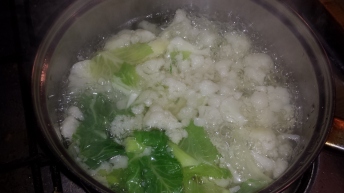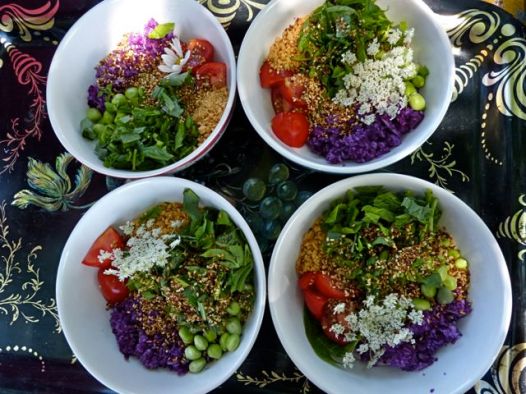
Traditional cauliflower cheese, but slow, and lacking that extra zing
A favourite British supper dish from my childhood is cauliflower cheese – a brilliant wheeze by parents keen to get their kids to eat vegetables, but also just plain delicious. But the British recipe involves making a heavy cheese sauce based on white sauce (the French call it sauce anglaise) made with flour, butter and milk with some grated cheese melted into it.
Nah. I realised that you can make a scrumptious cheese sauce without any of that faffing… AND you can pin a label on it that says gluten-free and low-carb. And it only takes 15 minutes from getting the idea.
Last night I was hungry, but not in the mood to spend ages in the kitchen. Nor in the mood for cheese cold from the fridge eaten with an apple (often my can’t-be-bothered-to-cook solution).
 I had a cauliflower, I had cheese, I had spices and other interesting ingredients. I had 15 minutes. Hey! A lightbulb pinged on in my head. Cauliflower…cheese…quick…
I had a cauliflower, I had cheese, I had spices and other interesting ingredients. I had 15 minutes. Hey! A lightbulb pinged on in my head. Cauliflower…cheese…quick…
Half the cauliflower chopped into bite-sized florets,pan on with salted water coming to the boil…

Cheesey spicy tangy things pulled from the fridge and off the spice shelf…
Cheeses chopped, spring onions chopped, bit of bacon chopped. Dash of cayenne, good pinch of parsley… screw of black pepper… spoonful of sour cream ready…
Fling everything into a non-stick pan, simmer while you drain the just-cooked cauli…
Cauli in bowl, sauce given final stir and poured over cauli with a good screw of fresh black pepper…
EAT!
What and how
Feeds two hungry people for supper.
1 cauliflower, chopped into bite-sized florets
3 spring onions, chopped
200g (total) of various cheeses eg feta, cheddar, brie, edam etc
Dash of cayenne (according to your preferences)
1 tbsp dried parsley or a handful of fresh parsley, finely chopped
1 tbsp sour cream
[Optional for carnivores: 50g bacon]
 Boil the cauliflower in salted water for 3 to 4 minutes, until the leaves are bright green and the florets just tender. Drain and keep warm.
Boil the cauliflower in salted water for 3 to 4 minutes, until the leaves are bright green and the florets just tender. Drain and keep warm.
While the cauli is cooking, chop your cheeses (last night I opted for feta and cheddar), put into a pan (NB you don’t need oil as there’s enough oil in the cheese as it melts) with the spring onions, cayenne, bacon (if you’re not veggie) and sour cream. Be careful with adding salt – the cheese (and bacon) are usually salty enough, but season to your taste.
 Bring to the boil gently and simmer until the cheese melts and everything is bubbling. Two or three minutes, maximum five if you’re using really hard cheese. While it’s bubbling, it will be time to drain the cauli.
Bring to the boil gently and simmer until the cheese melts and everything is bubbling. Two or three minutes, maximum five if you’re using really hard cheese. While it’s bubbling, it will be time to drain the cauli.
Serve in bowls – just pour the cheese sauce over the cauli, give it all a good grind of black pepper, and serve with crusty bread, if you like.
Eat immediately! Scrummy yummy…







